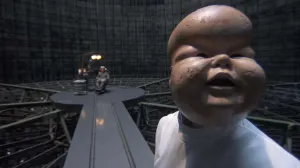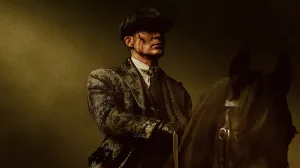Throughout the history of horror cinema, some of its biggest icons have been reimagined in playful ways, as the juxtaposition of deadly figures with more innocent incarnations of them delights audiences, even if this strips the characters of their intensity. One outlier in this trend, however, is that Michael Myers from the Halloween franchise hasn’t received the same treatment as some of his peers, as characters like Freddy Krueger or Jason Voorhees have been adapted into a variety of mediums. This has allowed the murderous killer to remain as frightening now as he was when we met him in Halloween back in 1978, with the new illustrated adaptation of that debut story The Legend of Halloween venturing into uncharted waters for the maniac. Luckily, while the events of the film have been given a more whimsical facelift, creators David Gordon Green and Onur Tukel have managed to make an adventure that is playful yet never tones down the terror.
Videos by ComicBook.com
Using the original screenplay from John Carpenter and Debra Hill as inspiration, The Legend of Halloween spares no expense at embracing the important plot points of Halloween. Readers will see Michael Myers murder his sister as a young boy, escape a mental institution, and terrorize his hometown of Haddonfield, Illinois as he targets Laurie Strode for unknown reasons, leading to a deadly collision with Dr. Loomis.
When a Halloween fan hears “an illustrated adaptation,” it’s easy to assume the goal was to offer fans something akin to a Little Golden Book that would be designed for a collector more than for anyone to actually enjoy. Whatever trepidations you might have about Legend of Halloween, one of the biggest signs that it would live up to the franchise’s standards is that it was written by Green, who directed 2018’s Halloween. Additionally, producers on that film Malek Akkad and Ryan Freimann oversaw this effort, confirming this was merely more than a cash-in on the famous property.

While the book remains faithful to the gruesome original story, Green does have fun with the concept. Rather than merely condensing the overall story of the original, he reimagines the narrative into a rhyme-scheme that is often found in children’s’ books. For example, when detailing how Michael killed his sister Judith, the book reads, “He walked into his sister’s room holding a large knife, he plunged it deep into her chest and ended Judith’s life.” You’d be hard-pressed to find any kids’ book being this macabre, but given the horrors of the crime, the words manage to not only be playful but also disturbing.
Matching the balance of the prose’s humor and horror is Tukel’s artwork. The pages are full of whimsical illustrations of Halloween iconography, exaggerating character proportions to make for innocent interpretations of the figures, though they are much more restrained than a caricature. It appears that Tukel settled on one character design he liked and then ran all of the important players through his stylistic algorithm to craft their looks in the book. Much like the original film, which showed restraint in its violence, the static images don’t have to appear gruesome to the reader and can instead rely on implied terror as opposed to covering a page in blood. Confirming how effective Myers is as a character, while he is reimagined in the book’s art style, he remains just as frightening as ever in this book, with the exaggerated poses of other characters taking care of the comical tone.
Green and Tukel’s love for the original film is evident on every page, but it’s clear that they aren’t afraid to have fun with this adaptation. While all the major beats are hit, the creators gleefully tease the source material a bit, including calling into question why Myers brought his sister’s tombstone to place in front of a victim.

The biggest strength of the book is that it makes a good litmus test for young readers with a burgeoning interest in horror. The lyrical writing and the fanciful images will surely tone down the intensity of the adventure, though the writers’ faithfulness to the source material results in just as high of a body count as the film. With there being no tame entry points into the franchise, as each entry is rated R, introducing young readers just beginning to experiment with horror to The Legend of Halloween will serve as an effective introduction to Michael Myers, paving a way for their ultimate collision with the character in his many films.
Far from being just a gimmick or novelty, The Legend of Halloween honors the iconic film by sticking with its sinister storyline, even if the rhyming prose and silly pictures might turn off those who are drawn to the series by its unsettling subject matter. Veteran fans will appreciate the book offering a new perspective on the 1978 film’s terror, while young readers will never be able to forget Michael Myers after reading, no matter how hard they try.
Rating: 4 out of 5
The Legend of Halloween is available now for pre-order.








